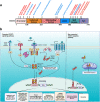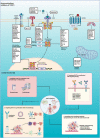Unraveling the complexity of STAT3 in cancer: molecular understanding and drug discovery
- PMID: 38245798
- PMCID: PMC10799433
- DOI: 10.1186/s13046-024-02949-5
Unraveling the complexity of STAT3 in cancer: molecular understanding and drug discovery
Abstract
Signal transducer and activator of transcription 3 (STAT3) is a transcriptional factor involved in almost all cancer hallmark features including tumor proliferation, metastasis, angiogenesis, immunosuppression, tumor inflammation, metabolism reprogramming, drug resistance, cancer stemness. Therefore, STAT3 has become a promising therapeutic target in a wide range of cancers. This review focuses on the up-to-date knowledge of STAT3 signaling in cancer. We summarize both the positive and negative modulators of STAT3 together with the cancer hallmarks involving activities regulated by STAT3 and highlight its extremely sophisticated regulation on immunosuppression in tumor microenvironment and metabolic reprogramming. Direct and indirect inhibitors of STAT3 in preclinical and clinical studies also have been summarized and discussed. Additionally, we highlight and propose new strategies of targeting STAT3 and STAT3-based combinations with established chemotherapy, targeted therapy, immunotherapy and combination therapy. These efforts may provide new perspectives for STAT3-based target therapy in cancer.
Keywords: Cancer; Immunosuppression; Inhibitors; Metabolic reprogramming; Modulators; STAT3.
© 2024. The Author(s).
Conflict of interest statement
The authors declare that they have no competing interests.
Figures




Similar articles
-
Biological Hallmarks and Emerging Strategies to Target STAT3 Signaling in Multiple Myeloma.Cells. 2022 Mar 10;11(6):941. doi: 10.3390/cells11060941. Cells. 2022. PMID: 35326392 Free PMC article. Review.
-
Targeting STAT3 in Cancer Immunotherapy.Mol Cancer. 2020 Sep 24;19(1):145. doi: 10.1186/s12943-020-01258-7. Mol Cancer. 2020. PMID: 32972405 Free PMC article. Review.
-
Signal transducer and activator of transcription 3 as a therapeutic target for cancer and the tumor microenvironment.Arch Pharm Res. 2016 Aug;39(8):1085-99. doi: 10.1007/s12272-016-0795-8. Epub 2016 Aug 11. Arch Pharm Res. 2016. PMID: 27515050 Review.
-
Small molecule inhibitors of STAT3 for cancer therapy.Curr Med Chem. 2011;18(26):4012-8. doi: 10.2174/092986711796957284. Curr Med Chem. 2011. PMID: 21824090 Review.
-
The JAK/STAT3 axis: A comprehensive drug target for solid malignancies.Semin Cancer Biol. 2017 Aug;45:13-22. doi: 10.1016/j.semcancer.2017.06.001. Epub 2017 Jun 21. Semin Cancer Biol. 2017. PMID: 28647610 Review.
Cited by
-
STAT1 and STAT4 expression as prognostic biomarkers in patients with bladder cancer.Mol Clin Oncol. 2025 Feb 6;22(4):33. doi: 10.3892/mco.2025.2828. eCollection 2025 Apr. Mol Clin Oncol. 2025. PMID: 39989605 Free PMC article.
-
Blockade of the STAT3/BCL-xL Axis Leads to the Cytotoxic and Cisplatin-Sensitizing Effects of Fucoxanthin, a Marine-Derived Carotenoid, on Human Bladder Urothelial Carcinoma Cells.Mar Drugs. 2025 Jan 22;23(2):54. doi: 10.3390/md23020054. Mar Drugs. 2025. PMID: 39997178 Free PMC article.
-
Unveiling the future of cancer stem cell therapy: a narrative exploration of emerging innovations.Discov Oncol. 2025 Mar 22;16(1):373. doi: 10.1007/s12672-025-02102-4. Discov Oncol. 2025. PMID: 40120008 Free PMC article. Review.
-
Saikosaponin D suppresses esophageal squamous cell carcinoma via the PI3K-AKT signaling pathway.Naunyn Schmiedebergs Arch Pharmacol. 2025 May;398(5):6059-6070. doi: 10.1007/s00210-024-03676-6. Epub 2024 Dec 5. Naunyn Schmiedebergs Arch Pharmacol. 2025. PMID: 39638887
-
Downexpression of miR- 17 - 5p and miR- 125a- 5p is Potentially Associated with the Renal Impairment Through STAT- 3 and CD69 in Multiple Myeloma Adult Patients.Biochem Genet. 2025 Apr 23. doi: 10.1007/s10528-025-11094-3. Online ahead of print. Biochem Genet. 2025. PMID: 40266492
References
Publication types
MeSH terms
Substances
Grants and funding
LinkOut - more resources
Full Text Sources
Medical
Miscellaneous

